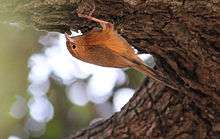Tawny-bellied babbler
| Tawny-bellied babbler | |
|---|---|
.jpg) | |
| Scientific classification | |
| Kingdom: | Animalia |
| Phylum: | Chordata |
| Class: | Aves |
| Order: | Passeriformes |
| Family: | Timaliidae |
| Genus: | Dumetia Blyth, 1852 |
| Species: | D. hyperythra |
| Binomial name | |
| Dumetia hyperythra (Franklin, 1831) | |
The tawny-bellied babbler (Dumetia hyperythra) also known in older Indian works as the rufous-bellied babbler is a small babbler that forages in groups in low scrub forests. Like other members of the large Old World babbler family they are passerine birds characterised by soft fluffy plumage. Found in small groups that skulk inside scrub, three subspecies are recognized in South Asia. The nominate hyperythra and albogularis found in India and phillipsi of Sri Lanka[2][3][4]
Description
The tawny-bellied babbler is a small babbler at 13 cm including its long tail. It is dark brown above and orange-buff below, with a rufous grey crown. The feathers on the forehead are stiff and the tail has cross rays and is otherwise olive brown. The throat is white in the populations of peninsular India and Sri Lanka. The Sri Lankan population however has a larger beak and paler underparts.[5]
Distribution and habitat
The babbler is found from north-central India to Sri Lanka.[6] Its natural habitat is scrub and tall grassland.
Behaviour
_by_Dharani_Prakash.jpg)

The babbler builds its nest in a bush, concealed in dense masses of foliage. The normal clutch is three or four eggs. Like most babblers, it is not migratory, and has short rounded wings and a weak flight. It feeds mainly on insects and nectar.The vocalisation patterns are distinct among the subspecies [7][8]
References
- ↑ BirdLife International (2012). "Dumetia hyperythra". IUCN Red List of Threatened Species. Version 2013.2. International Union for Conservation of Nature. Retrieved 26 November 2013.
- ↑ Edward Blyth (1819). "Catalogue of the Birds in the Museum Asiatic Society": 140.
- ↑ "Dumetia hyperythra (Franklin, 1831)". Avibase. Retrieved October 23, 2015.
- ↑ Ernst Mayr; Raymond A. Paynter Jr., eds. (1964). "Check-list of Birds of the World Volume X". A Continuation of the work of James L. Peters. p. 317. Retrieved November 14, 2015.
- ↑ Whistler, Hugh (1949). Popular Handbook of Indian Birds (4th ed.). London: Gurney and Jackson. pp. 50–51.
- ↑ "Babblers & fulvettas « IOC World Bird List". www.worldbirdnames.org. Retrieved 2017-07-18.
- ↑ Pamela C. Rasmussen (22 Nov 2011). "Dumetia hyperythra albogularis". Avian Vocalisations Center, Michigan State University. Retrieved November 14, 2015.
- ↑ Deepal Warakagoda (22 Mar 2003). "Dumetia hyperythra phillipsi". Avian Vocalisations Center, Michigan State University. Retrieved November 14, 2015.
- Birds of India by Grimmett, Inskipp and Inskipp, ISBN 0-691-04910-6
- A Field Guide to the Birds of the Indian Subcontinent by Kazmierczak and van Perlo, ISBN 1-873403-79-8
- Collar, N. J. & Robson, C. 2007. Family Timaliidae (Babblers) pp. 70 – 291 in; del Hoyo, J., Elliott, A. & Christie, D.A. eds. Handbook of the Birds of the World, Vol. 12. Picathartes to Tits and Chickadees. Lynx Edicions, Barcelona.
| Wikimedia Commons has media related to Dumetia hyperythra. |
